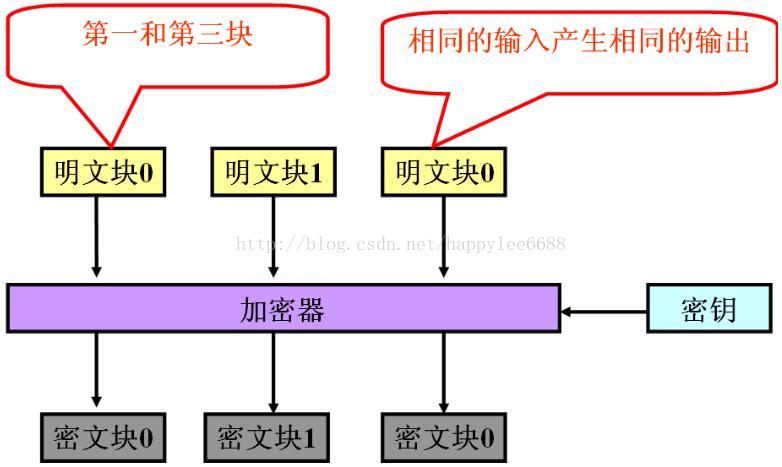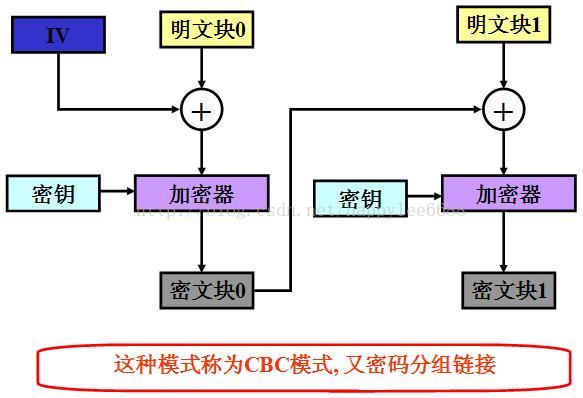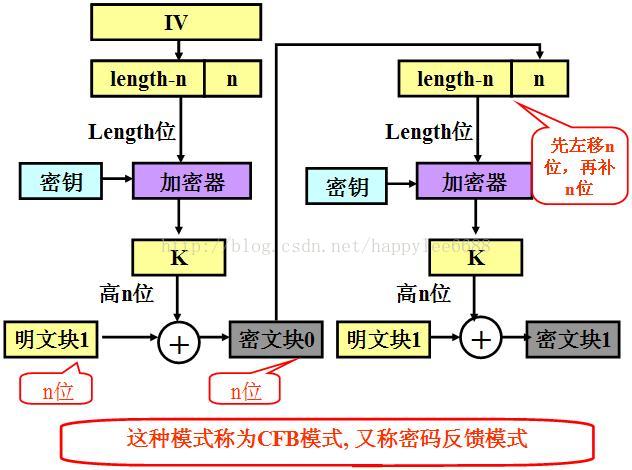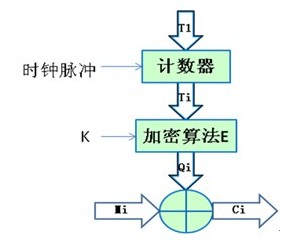5.Java 加解密技术系列之 DES
Posted
tags:
篇首语:本文由小常识网(cha138.com)小编为大家整理,主要介绍了5.Java 加解密技术系列之 DES相关的知识,希望对你有一定的参考价值。
Java 加解密技术系列之 DES
- 序
- 背景
- 概念
- 基本原理
- 主要流程
- 分组模式
- 代码实现
- 结束语
序
前 几篇文章讲的都是单向加密算法,其中涉及到了 BASE64、MD5、SHA、HMAC 等几个比较常见的加解密算法。这篇文章,以及后面几篇,打算介绍几个对称加密算法,比如:DES、3DES(TripleDES)、AES 等。那么,这篇文章主要是对 DES 大概讲一下。
背景
在 讨论 DES 之前,首先了解一下什么是对称加密算法吧。对于对称加密算法,他应用的时间比较早,技术相对来说比较成熟,在对称加密算法中,数据发信方将明文(原始数 据)和加密密钥一起经过特殊加密算法处理后,使其变成复杂的加密密文发送出去。收信方收到密文后,若想解读原文,则需要使用加密用过的密钥及相同算法的逆 算法对密文进行解密,才能使其恢复成可读明文。
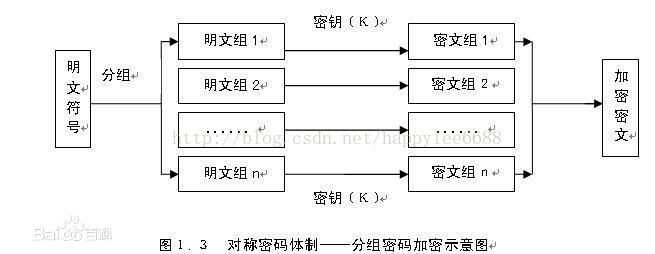
在对称加密算法中,使用的密钥只有一个,发收信双方都使用这个密钥对数据进行加密和解密,这就要求解密方事先必须知道加密密钥。对称加密算法的特点是算法公开、计算量小。不足之处是,交易双方都使用同样钥匙,安全性得不到保证。
概念
那么,什么是 DES?他是怎么来的?相信很多人都很感兴趣,因为以前在开发的时候,对进度的要求比较严,很多时候根本就没有时间来了解这些东西。因此,今天专门来研究研究这个东西。
DES, 全称为“Data Encryption Standard”,中文名为“数据加密标准”,是一种使用密钥加密的块算法。DES 算法为密码体制中的对称密码体制,又被称为美国数据加密标准,是 1972 年美国 IBM 公司研制的对称密码体制加密算法。 明文按 64 位进行分组,密钥长 64 位,密钥事实上是 56 位参与 DES 运算(第8、16、24、32、40、48、56、64 位是校验位, 使得每个密钥都有奇数个 1)分组后的明文组和 56 位的密钥按位替代或交换的方法形成密文组的加密方法。
基本原理
入口参数有三个:key、data、mode。key 为加密解密使用的密钥,data 为加密 解密的数据,mode 为其工作模式。当模式为加密模式时,明文按照 64 位进行分组,形成明文组,key 用于对数据加密,当模式为解密模式时,key 用于对数据解密。实际运用中,密钥只用到了 64 位中的 56 位,这样才具有高的安全性。

主要流程
DES 算法把 64 位的明文输入块变为 64 位的密文输出块,它所使用的密钥也是 64 位,其算法主要分为两步:
- 初始置换
其功能是把输入的 64 位数据块按位重新组合,并把输出分为
L0、R0 两部分,每部分各长 32 位,其置换规则为将输入的第 58 位换到第一位,第 50 位换到第 2 位 ……
依此类推,最后一位是原来的第 7 位。L0、R0 则是换位输出后的两部分,L0 是输出的左 32 位,R0 是右 32
位,例:设置换前的输入值为 D1 D2 D3 …… D64,则经过初始置换后的结果为:L0 = D58 D50 …… D8;R0 = D57
D49 …… D7。
整个算法 的主流程图如下:
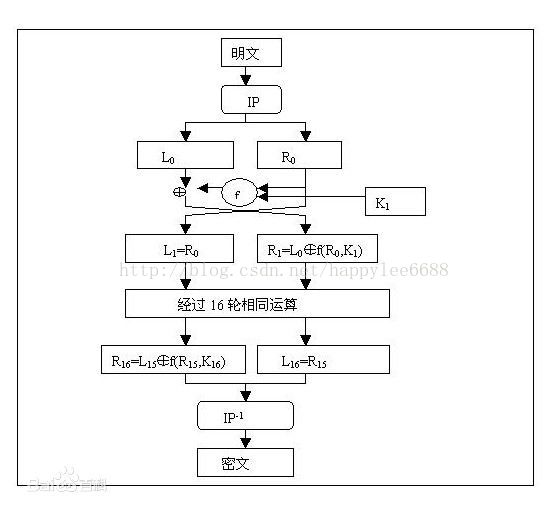
import com.google.common.base.Strings; import sun.misc.BASE64Decoder; import sun.misc.BASE64Encoder; import javax.crypto.Cipher; import javax.crypto.KeyGenerator; import javax.crypto.SecretKey; import javax.crypto.SecretKeyFactory; import javax.crypto.spec.DESKeySpec; import java.security.InvalidKeyException; import java.security.Key; import java.security.NoSuchAlgorithmException; import java.security.SecureRandom; import java.security.spec.InvalidKeySpecException; /** * Created by xiang.li on 2015/2/28. * DES 加解密工具类 * * <pre> * 支持 DES、DESede(TripleDES,就是3DES)、AES、Blowfish、RC2、RC4(ARCFOUR) * DES key size must be equal to 56 * DESede(TripleDES) key size must be equal to 112 or 168 * AES key size must be equal to 128, 192 or 256,but 192 and 256 bits may not be available * Blowfish key size must be multiple of 8, and can only range from 32 to 448 (inclusive) * RC2 key size must be between 40 and 1024 bits * RC4(ARCFOUR) key size must be between 40 and 1024 bits * 具体内容 需要关注 JDK Document http://.../docs/technotes/guides/security/SunProviders.html * </pre> */ public class DES { /** * 定义加密方式 */ private final static String KEY_DES = "DES"; private final static String KEY_AES = "AES"; // 测试 /** * 全局数组 */ private final static String[] hexDigits = { "0", "1", "2", "3", "4", "5", "6", "7", "8", "9", "a", "b", "c", "d", "e", "f" }; /** * 初始化密钥 * @return */ public static String init() { return init(null); } /** * 初始化密钥 * @param seed 初始化参数 * @return */ public static String init(String seed) { SecureRandom secure = null; String str = ""; try { if (null != secure) { // 带参数的初始化 secure = new SecureRandom(decryptBase64(seed)); } else { // 不带参数的初始化 secure = new SecureRandom(); } KeyGenerator generator = KeyGenerator.getInstance(KEY_DES); generator.init(secure); SecretKey key = generator.generateKey(); str = encryptBase64(key.getEncoded()); } catch (Exception e) { e.printStackTrace(); } return str; } /** * 转换密钥 * @param key 密钥的字节数组 * @return */ private static Key byteToKey(byte[] key) { SecretKey secretKey = null; try { DESKeySpec dks = new DESKeySpec(key); SecretKeyFactory factory = SecretKeyFactory.getInstance(KEY_DES); secretKey = factory.generateSecret(dks); // 当使用其他对称加密算法时,如AES、Blowfish等算法时,用下述代码替换上述三行代码 // secretKey = new SecretKeySpec(key, KEY_DES); } catch (InvalidKeyException e) { e.printStackTrace(); } catch (NoSuchAlgorithmException e) { e.printStackTrace(); } catch (InvalidKeySpecException e) { e.printStackTrace(); } return secretKey; } /** * DES 解密 * @param data 需要解密的字符串 * @param key 密钥 * @return */ public static String decryptDES(String data, String key) { // 验证传入的字符串 if (Strings.isNullOrEmpty(data)) { return ""; } // 调用解密方法完成解密 byte[] bytes = decryptDES(hexString2Bytes(data), key); // 将得到的字节数组变成字符串返回 return new String(bytes); } /** * DES 解密 * @param data 需要解密的字节数组 * @param key 密钥 * @return */ public static byte[] decryptDES(byte[] data, String key) { byte[] bytes = null; try { Key k = byteToKey(decryptBase64(key)); Cipher cipher = Cipher.getInstance(KEY_DES); cipher.init(Cipher.DECRYPT_MODE, k); bytes = cipher.doFinal(data); } catch (Exception e) { e.printStackTrace(); } return bytes; } /** * DES 加密 * @param data 需要加密的字符串 * @param key 密钥 * @return */ public static String encryptDES(String data, String key) { // 验证传入的字符串 if (Strings.isNullOrEmpty(data)) { return ""; } // 调用加密方法完成加密 byte[] bytes = encryptDES(data.getBytes(), key); // 将得到的字节数组变成字符串返回 return byteArrayToHexString(bytes); } /** * DES 加密 * @param data 需要加密的字节数组 * @param key 密钥 * @return */ public static byte[] encryptDES(byte[] data, String key) { byte[] bytes = null; try { Key k = byteToKey(decryptBase64(key)); Cipher cipher = Cipher.getInstance(KEY_DES); cipher.init(Cipher.ENCRYPT_MODE, k); bytes = cipher.doFinal(data); } catch (Exception e) { e.printStackTrace(); } return bytes; } /** * BASE64 解密 * @param key 需要解密的字符串 * @return 字节数组 * @throws Exception */ public static byte[] decryptBase64(String key) throws Exception { return (new BASE64Decoder()).decodeBuffer(key); } /** * BASE64 加密 * @param key 需要加密的字节数组 * @return 字符串 * @throws Exception */ public static String encryptBase64(byte[] key) throws Exception { return (new BASE64Encoder()).encodeBuffer(key); } /** * 将一个字节转化成十六进制形式的字符串 * @param b 字节数组 * @return 字符串 */ private static String byteToHexString(byte b) { int ret = b; //System.out.println("ret = " + ret); if (ret < 0) { ret += 256; } int m = ret / 16; int n = ret % 16; return hexDigits[m] + hexDigits[n]; } /** * 转换字节数组为十六进制字符串 * @param bytes 字节数组 * @return 十六进制字符串 */ private static String byteArrayToHexString(byte[] bytes) { StringBuffer sb = new StringBuffer(); for (int i = 0; i < bytes.length; i++) { sb.append(byteToHexString(bytes[i])); } return sb.toString(); } /** * 转换十六进制字符串为字节数组 * @param hexstr 十六进制字符串 * @return */ public static byte[] hexString2Bytes(String hexstr) { byte[] b = new byte[hexstr.length() / 2]; int j = 0; for (int i = 0; i < b.length; i++) { char c0 = hexstr.charAt(j++); char c1 = hexstr.charAt(j++); b[i] = (byte) ((parse(c0) << 4) | parse(c1)); } return b; } /** * 转换字符类型数据为整型数据 * @param c 字符 * @return */ private static int parse(char c) { if (c >= ‘a‘) return (c - ‘a‘ + 10) & 0x0f; if (c >= ‘A‘) return (c - ‘A‘ + 10) & 0x0f; return (c - ‘0‘) & 0x0f; } /** * 测试方法 * @param args */ public static void main(String[] args) { String key = DES.init(); System.out.println("DES密钥:\n" + key); String word = "123"; String encWord = encryptDES(word, key); System.out.println(word + "\n加密后:\n" + encWord); System.out.println(word + "\n解密后:\n" + decryptDES(encWord, key)); } }
结束语
到 这里,这篇文章也就差不多要结束了,希望以上的内容对各位看官有稍许的帮助,哪怕一点也好。其实,在日常的开发中,如果不是进度控制的特别严格,对于这些 原理性的东西,我们还是需要知道的,对于那些细节的东西,可以不用死记硬背,有网的话,随用随查就可以了。但这个前提是,原理性的东西必须要懂,知道了原 理,就会有解决思路,有了思路,解决问题是迟早的事,细节嘛,不用那么纠结,做的时候考虑到就行了,毕竟时间是有限的。
以上是关于5.Java 加解密技术系列之 DES的主要内容,如果未能解决你的问题,请参考以下文章
